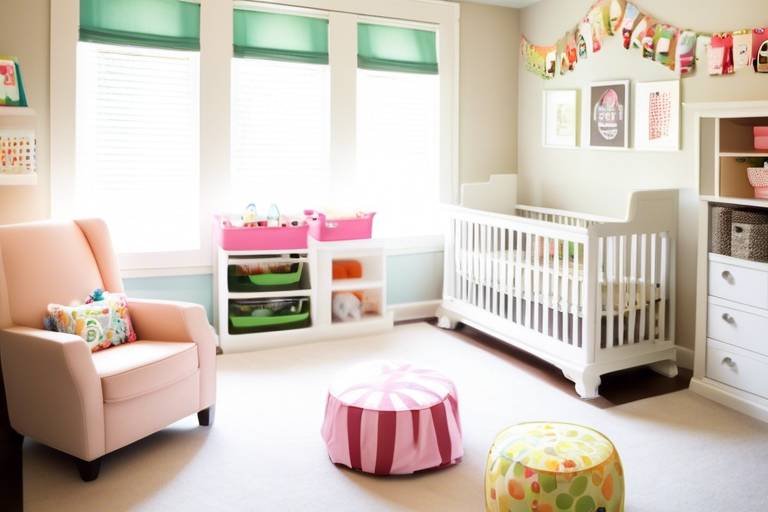Balancing Family Time and Personal Space
In today’s fast-paced world, finding the right balance between family time and personal space can feel like walking a tightrope. On one hand, we crave those moments spent with our loved ones, sharing laughs, creating memories, and nurturing relationships. On the other hand, we all need that precious time to recharge our batteries, reflect on our thoughts, and simply enjoy our own company. It’s a delicate dance, but it’s entirely possible to achieve harmony in a busy household. So, how do we make this balancing act work without feeling overwhelmed?
First, let’s understand why both family time and personal space are essential. Family time is not just about being in the same room; it’s about quality interactions that strengthen bonds and create a supportive environment. When families engage in activities together, they build trust and communication skills, which are the cornerstones of any healthy relationship. But, just as a plant needs both sunlight and water to thrive, individuals also require their own space to grow. This is where personal space comes into play, allowing each family member to pursue their interests, reflect on their feelings, and ultimately, become a happier and more fulfilled person.
Now, let’s dive deeper into how to maintain this balance. It starts with recognizing the importance of both elements. Family members should understand that needing time alone doesn’t equate to a lack of love or commitment. Instead, it’s a fundamental aspect of maintaining mental health. Imagine trying to fill a cup from an empty pitcher; without personal time to recharge, we can’t pour our best selves into our family relationships. This realization is crucial for fostering an environment where everyone feels respected and valued.
To achieve this balance, clear boundaries must be established. It’s essential to communicate openly about personal space needs without creating conflict. For instance, if someone in the family feels overwhelmed and needs some quiet time, it’s important to express this need calmly and clearly. This communication can be facilitated through family meetings or one-on-one discussions, ensuring that everyone has a chance to share their feelings. By doing so, family members can better understand each other’s needs and work towards a mutually respectful environment.
Respecting each other’s space is equally important. It’s not just about having a designated area to retreat to; it’s about creating a culture of mutual respect within the family. Encourage family members to honor each other’s need for solitude. For example, if one person is reading a book in their room, others should understand that this is their time to unwind. By fostering this respect, families can create a healthier dynamic where everyone feels comfortable expressing their needs.
Finding quality time together while also respecting individual preferences is a challenge that requires creativity. Think about activities that can cater to both family bonding and personal space. For example, family game nights can be a fun way to connect, but perhaps everyone can choose their own game to play, allowing for both group interaction and personal enjoyment. Or consider family outings where everyone gets a bit of free time to explore their interests, like visiting a park where kids can play while adults enjoy a moment of peace on a bench.
Ultimately, a well-structured family schedule can help in balancing time spent together and apart. Creating a routine that accommodates everyone’s needs is key. This might involve setting aside specific times for family dinners, movie nights, or outings, while also carving out moments for personal time. For instance, you could allocate Sunday afternoons for family activities while reserving a couple of hours each week for individual pursuits. This structured approach ensures that everyone is on the same page while also giving each member the freedom to recharge.
Incorporating alone time into the family schedule is vital. It’s essential to recognize that everyone needs a chance to step back and recharge. Scheduling personal time isn’t just a nice-to-have; it’s a necessity for maintaining emotional well-being. By deliberately planning these moments into the week, families can significantly improve their overall dynamic.
Finally, planning family activities that cater to varying interests can enhance bonding experiences. It’s all about finding that sweet spot where everyone feels included yet respected. You might choose to rotate who picks the family activity each week, ensuring that everyone gets a chance to engage in something they love, whether it’s a movie night, a hiking trip, or even a simple picnic in the backyard.
- How do I communicate my need for personal space to my family?
It’s best to express your needs calmly and clearly, perhaps during a family meeting or a relaxed moment. Use "I" statements to avoid sounding accusatory, such as "I need some time to recharge this evening." - What are some activities that can satisfy both family bonding and personal space?
Consider activities like family game nights where everyone can choose their own game, or outings to parks where individuals can explore while staying connected. - How can I encourage my family to respect my personal space?
Lead by example. When you respect their space, they are more likely to reciprocate. Open discussions about everyone’s needs can also foster mutual respect.

The Importance of Family Time
This article explores the delicate equilibrium between nurturing family relationships and preserving individual space, offering practical tips and insights for achieving harmony in a busy household.
In our fast-paced world, where everyone seems to be rushing from one obligation to another, the significance of family time often gets overlooked. But let’s pause for a moment and think about this: what truly makes a house a home? It’s the laughter shared over dinner, the stories exchanged during family game night, and the comfort of knowing that you have a support system right by your side. Spending quality time with family isn’t just a luxury; it’s a necessity for emotional well-being.
Engaging in activities together can strengthen the bonds that tie family members. When we prioritize family time, we create a nurturing environment where love, trust, and communication flourish. Imagine a garden; without water and sunlight, the plants can’t thrive. Similarly, without dedicated time together, family relationships can wilt. Research has shown that families who regularly engage in shared activities report higher levels of happiness and satisfaction. This is because these moments foster a sense of belonging and security.
Moreover, family time can serve as a powerful antidote to stress. In moments of chaos, having a family to lean on can be incredibly comforting. It’s like having a cozy blanket on a chilly evening; it wraps you in warmth and makes you feel safe. When family members come together, they can share their challenges, support one another, and celebrate successes. This collective emotional support can significantly enhance individual resilience.
Here are some compelling reasons why family time should be at the top of your priority list:
- Strengthens Relationships: Regular interactions help build trust and deepen connections.
- Boosts Mental Health: Quality time reduces feelings of loneliness and anxiety.
- Enhances Communication: Open dialogue during family activities encourages sharing and understanding.
- Creates Lasting Memories: Fun experiences together become cherished memories that family members will hold dear for years to come.
In conclusion, prioritizing family time is not just about making memories; it’s about creating a solid foundation for emotional health and well-being. By investing time in your family, you’re not just nurturing relationships; you’re also fostering a sense of community and belonging that can carry you through life’s ups and downs. So, let’s make a conscious effort to put down our devices, turn off the distractions, and truly connect with our loved ones. After all, the moments we share are the threads that weave the fabric of our family story.
Personal space is vital for mental health and self-reflection. Here, we delve into why individuals require time alone and how it contributes to personal growth and happiness.
Establishing clear boundaries is crucial for maintaining personal space while nurturing family ties. This subsection outlines effective strategies for communicating needs without causing conflict.
Open communication is key to expressing personal space needs. This section offers tips on how to discuss boundaries with family members constructively.
Mutual respect for personal space fosters a healthier family dynamic. Here we explore ways to encourage family members to honor each other’s needs.
Balancing personal space with family time requires creativity. This part suggests activities that allow for bonding while also respecting individual preferences.
A well-structured family schedule can help balance time spent together and apart. This section discusses how to create a routine that accommodates everyone's needs.
Including designated alone time in the family schedule ensures everyone has a chance to recharge. This subsection highlights the importance of scheduling personal time.
Choosing the right family activities can enhance bonding experiences. Here, we suggest fun and engaging options that cater to varying interests and preferences.
Q: Why is family time important?
A: Family time strengthens relationships, boosts mental health, and creates lasting memories.
Q: How can I ensure my family respects my personal space?
A: Communicate your needs openly and set clear boundaries.
Q: What are some activities we can do together as a family?
A: Consider game nights, outdoor adventures, or cooking together to enhance bonding.

Recognizing Personal Space Needs
In our fast-paced world, it’s easy to get lost in the hustle and bustle of daily life, often forgetting the importance of personal space. Just like a plant needs sunlight and water to thrive, individuals need their own space to grow and flourish. Personal space isn’t just about having a room to yourself; it’s about creating an environment that fosters mental health and self-reflection. When we recognize our personal space needs, we not only enhance our own well-being but also contribute positively to our family dynamics.
Think of personal space as a breath of fresh air in a crowded room. It allows us to recharge our batteries, think clearly, and reconnect with our inner selves. Everyone has different needs when it comes to personal space. Some may require a few quiet moments each day, while others may need entire weekends to themselves. It’s crucial to understand that these needs are not selfish; rather, they are essential for maintaining a healthy balance between family interactions and personal time.
Recognizing personal space needs can be a game changer in a busy household. Here are a few key points to consider:
- Awareness: Being aware of how you feel when you’re surrounded by family can help you identify when you need some alone time.
- Communication: Talking openly about your needs can prevent misunderstandings and promote a supportive environment.
- Respect: Just as you have your own space needs, so do your family members. Respecting their boundaries fosters mutual understanding.
Moreover, personal space is not solely about physical distance; it also encompasses emotional and psychological boundaries. When you take the time to understand your own needs, you’re better equipped to recognize and respect the needs of others. This mutual respect creates a harmonious atmosphere where everyone feels valued and understood. It’s like a well-tuned orchestra, where each instrument plays its part without overshadowing the others.
In essence, recognizing personal space needs is a vital step towards achieving a balanced family life. By honoring these needs, you not only nurture your own well-being but also cultivate a more supportive and loving family environment. So, the next time you feel overwhelmed, take a moment to reflect on your personal space requirements. It might just be the key to unlocking a happier, healthier family dynamic.
Here are some common questions regarding personal space needs:
- What is personal space? Personal space refers to the physical and emotional distance we need to feel comfortable and secure.
- How can I communicate my need for personal space to my family? Open and honest communication is crucial. Explain your feelings and why personal space is important to you.
- What if my family members don’t understand my need for space? It may take time. Be patient and continue to express your needs calmly and respectfully.

Setting Boundaries
Establishing clear boundaries within a family is not just a necessity; it’s a vital ingredient for a harmonious home. Think of boundaries as the invisible lines that help define personal space and individual needs. Just like a well-tended garden needs fences to keep out unwanted weeds, our emotional well-being requires boundaries to flourish. When we talk about setting boundaries, we're not talking about building walls that isolate us from our loved ones. Instead, it's about creating a safe space where everyone can thrive.
To effectively set boundaries, it’s essential to communicate openly and honestly with family members. This doesn’t mean you need to have a formal meeting over dinner, but rather, it can be a casual conversation that emphasizes the importance of each person's needs. For instance, if you need time to unwind after work, share that with your family. You might say, “Hey, I love spending time with you all, but I need about 30 minutes to recharge after my day.” This way, you’re not shutting them out; you’re simply expressing your needs in a way that they can understand.
Another effective strategy is to model the behavior you wish to see. If you respect your family members' boundaries, they are more likely to respect yours. For example, if your teenager needs privacy in their room, make sure to honor that space. In return, they will be more likely to recognize when you need some quiet time too. It’s a reciprocal relationship that fosters trust and understanding.
Here are some practical tips for setting boundaries:
- Be Clear and Specific: Vague requests can lead to misunderstandings. If you need quiet time, specify when and for how long.
- Stay Calm: Approach discussions about boundaries with a calm demeanor. If emotions run high, it can lead to conflict rather than resolution.
- Use “I” Statements: Frame your needs in a way that focuses on your feelings. For example, “I feel overwhelmed when there’s too much noise” instead of “You are too loud.”
Remember, setting boundaries is not about being selfish; it's about ensuring everyone in the family can coexist peacefully while respecting their own needs. It takes practice, patience, and sometimes a little trial and error, but the rewards are immeasurable. You’ll find that when everyone feels respected and understood, family interactions become much more enjoyable, and the overall atmosphere in the home transforms into a nurturing environment.
Finally, it’s essential to regularly revisit and adjust these boundaries as necessary. Life changes, children grow, and family dynamics evolve. Make it a habit to check in with each other and see if the established boundaries still serve everyone’s needs. This ongoing dialogue not only strengthens relationships but also reinforces the idea that everyone’s feelings and needs are valid and worthy of respect.

Communicating with Family
When it comes to , the approach you take can make all the difference. Open and honest dialogue is the foundation of any strong relationship, especially within a family unit. But how do we express our needs for personal space without sounding selfish or dismissive? It’s a delicate balance, much like walking a tightrope. One misstep can lead to misunderstandings, while a well-placed word can strengthen bonds.
First and foremost, it’s important to create a safe environment for communication. This means choosing the right time and place to discuss sensitive topics. Avoid bringing up personal space needs during heated moments or when everyone is distracted. Instead, find a calm setting where family members can feel relaxed and open to conversation. This approach can lead to more productive discussions and a greater understanding of each other's needs.
When you start the conversation, use "I" statements to express your feelings. For example, saying "I need some time alone to recharge" is more effective than "You always invade my space." This subtle shift in language can help prevent defensive reactions and encourage a more empathetic response. It’s all about framing your needs in a way that emphasizes your perspective rather than placing blame.
Moreover, it’s crucial to actively listen to your family members as they share their thoughts. Encourage them to express their needs as well. This two-way communication fosters an atmosphere of mutual respect. You might say something like, “I want to hear how you feel about our family time and personal space. What do you need?” This not only shows that you value their opinion but also opens the door for a collaborative approach to finding a balance.
Sometimes, it may be beneficial to establish a family meeting where everyone can voice their thoughts on personal space and family time. This structured setting allows everyone to contribute without feeling overwhelmed. During these meetings, consider jotting down key points on a whiteboard or paper. This visual aid can help keep the conversation focused and ensure that everyone’s opinions are acknowledged.
Lastly, remember that communication is an ongoing process. After discussing personal space needs, check in with your family periodically to see how everyone feels. This not only shows that you care but also allows for adjustments as needed. Just like a garden, relationships require regular tending to flourish. By nurturing open lines of communication, you can cultivate a family dynamic that respects both personal space and togetherness.

Respecting Each Other's Space
In any family dynamic, respecting each other's space is not just a courtesy; it's a crucial element for maintaining harmony and understanding. Think of your family as a garden: each plant needs its own space to grow, flourish, and thrive. Similarly, each family member has unique needs and preferences that require acknowledgment. When we honor these individual spaces, we create an environment where everyone feels valued and understood.
Respecting personal space can manifest in various ways. For instance, it could mean allowing a teenager to retreat to their room after a long day or giving your partner some quiet time to unwind after work. These small gestures can significantly impact emotional well-being and foster a sense of belonging. But how do we ensure that this respect is mutual? Here are a few strategies:
- Encourage Open Dialogue: Create an atmosphere where family members feel safe to express their need for personal space without fear of judgment.
- Practice Active Listening: When someone communicates their need for space, listen attentively and validate their feelings. This shows that you care and respect their boundaries.
- Establish Physical Boundaries: Designate areas in the house where individuals can retreat for solitude, such as a reading nook or a home office. This gives everyone a physical space to recharge.
It's also essential to recognize that respecting space is a two-way street. Just as one family member might need time alone, others might seek connection and interaction. The key is to find a balance that respects everyone's needs. For example, if one parent enjoys a quiet evening with a book while the other prefers family game night, consider alternating between these activities. This way, each person's preferences are honored, and everyone gets a turn to enjoy their desired form of relaxation.
Moreover, mutual respect for space can be reinforced through family rituals. Establishing routines that incorporate both togetherness and solitude can help everyone understand and appreciate each other's needs. For instance, a Sunday family brunch can be followed by an afternoon of personal time, allowing each member to recharge for the week ahead.
In conclusion, respecting each other’s space is about recognizing the unique needs of each family member and creating an environment where everyone feels comfortable and supported. It’s a delicate balance, but with open communication and mutual understanding, families can cultivate a nurturing atmosphere that promotes both connection and individuality.
Q1: How can I communicate my need for personal space without hurting my family's feelings?
A1: Start by expressing your feelings using "I" statements, such as "I feel overwhelmed and need some quiet time." This approach focuses on your feelings rather than placing blame, making it easier for family members to understand your needs.
Q2: What if my family members don’t respect my need for space?
A2: It’s vital to have a calm and honest conversation about your feelings. Explain why personal space is important to you and how it benefits the entire family. Sometimes, people may not realize they are infringing on your space.
Q3: How can I encourage my family to respect each other’s space?
A3: Lead by example! Show your family how you respect their space, and encourage them to do the same. Creating family rituals that include both family time and personal time can also help everyone understand the importance of balance.

Finding Quality Time
In our fast-paced world, where everyone seems to be racing against the clock, finding quality time with family can feel like searching for a needle in a haystack. But here's the good news: it doesn't have to be a Herculean task! The key is to be intentional and creative about how you spend your time together. Think of it as crafting a beautiful tapestry; each moment you share is a thread that weaves your family closer together.
One effective way to ensure you're making the most of your family time is to turn ordinary moments into extraordinary memories. For instance, consider cooking a meal together. Not only does it allow everyone to contribute, but it also opens up opportunities for laughter and bonding over shared tasks. You might even discover hidden culinary talents among your family members! Plus, the aroma of a home-cooked meal can create a warm and inviting atmosphere that enhances your time together.
Another fantastic idea is to schedule regular family game nights. These evenings can be a delightful escape from the daily grind, providing a chance to connect and unwind. Choose a mix of board games, card games, or even video games that everyone enjoys. The competitive spirit can spark laughter and friendly banter, reinforcing your family bond. Remember, it’s not about winning or losing; it’s about enjoying each other’s company and creating lasting memories.
Outdoor activities can also serve as a wonderful backdrop for quality family time. Whether it’s hiking, biking, or simply taking a stroll in the park, being in nature can rejuvenate your spirits and enhance your connections. Nature has a magical way of bringing people together, allowing for open conversations and shared experiences. So, grab your family, head outside, and embrace the beauty of the world around you!
Finally, don’t underestimate the power of shared interests. If your family members have hobbies or activities they love, find ways to incorporate those into your time together. For example, if someone enjoys painting, why not host a family art night? Everyone can express their creativity while enjoying each other’s company. This not only fosters a sense of togetherness but also allows everyone to appreciate each other’s unique talents and interests.
In conclusion, finding quality time with your family is all about being intentional and creative. By transforming mundane moments into special memories, scheduling fun activities, and embracing shared interests, you can cultivate a nurturing environment that strengthens your family bonds. Remember, it’s not about how much time you spend together; it’s about how meaningful those moments are!
- How can I encourage my family to spend more quality time together?
Start by initiating activities that everyone enjoys and make it a regular part of your routine. - What if my family has different interests?
Try to find common ground or take turns choosing activities that cater to everyone's preferences. - How can I balance family time with personal space?
Establish a schedule that includes both family activities and designated personal time for each member.

Creating a Family Schedule
In the hustle and bustle of daily life, creating a family schedule can feel like trying to juggle flaming torches—challenging but rewarding when done right! A well-structured family schedule is more than just a calendar; it’s a roadmap to harmony, ensuring that everyone’s needs are met while fostering connection and togetherness. So, how do you go about crafting this essential tool? Let’s dive in!
First and foremost, it’s important to understand that a family schedule should be inclusive. Gather everyone around the table, perhaps over a cozy dinner, and discuss what each family member wants to include in the schedule. This can range from school activities, work commitments, and family game nights to personal downtime. By involving everyone in the planning process, you create a sense of ownership and responsibility, making it more likely that each person will respect the schedule.
When drafting your family schedule, consider using a digital calendar or a physical planner—whichever suits your family best. Digital calendars can be particularly handy as they allow for easy updates and reminders. Here’s a simple example of how you might structure a weekly family schedule:
| Day | Family Activities | Personal Time |
|---|---|---|
| Monday | Family Dinner | Reading/Relaxing |
| Tuesday | Game Night | Alone Time |
| Wednesday | Movie Night | Exercise |
| Thursday | Family Walk | Creative Time (art, writing) |
| Friday | Pizza Night | Self-Care |
| Saturday | Outdoor Adventure | Free Time |
| Sunday | Prep for the Week | Reflection/Planning |
This table is just a starting point! Feel free to adapt it to your family's unique needs. The key is to maintain a balance between family time and personal space. For instance, while it’s great to have family dinners and movie nights, it’s equally important to carve out moments where everyone can recharge individually.
Also, don’t forget to regularly revisit and adjust the schedule as needed. Life is unpredictable, and flexibility is crucial. Maybe your teenager has a last-minute school event, or you’ve decided to take a spontaneous family trip. Whatever the case, being open to changes will help maintain harmony and reduce stress.
In summary, a family schedule can be a game-changer in balancing time spent together and apart. By involving everyone in the planning process, utilizing tools that work for your family, and staying flexible, you can create a schedule that nurtures both family bonds and individual needs. So grab that planner, gather your loved ones, and start crafting your path to a more organized and harmonious household!
- How often should we update our family schedule? It's best to review the schedule weekly to accommodate any changes in activities or personal commitments.
- What if family members disagree on activities? Open communication is key. Encourage everyone to express their preferences and find a compromise that includes everyone's interests.
- Can we use technology to help with scheduling? Absolutely! Apps like Google Calendar or family organizer apps can make scheduling easier and more efficient.

Incorporating Alone Time
In the hustle and bustle of family life, it can be easy to overlook the necessity of alone time. However, carving out moments for oneself is not just a luxury; it's a vital component of maintaining mental health and emotional balance. Think of it like recharging your phone: if you never plug it in, it will eventually die. Similarly, without personal space, we risk running on empty, which can lead to irritability and burnout.
So, how can we effectively incorporate alone time into our busy family schedules? One practical approach is to establish a designated alone time for each family member. This could be as simple as setting aside an hour each day where everyone engages in their preferred solitary activity. Whether it's reading a book, meditating, or enjoying a hobby, this time allows individuals to unwind and reflect.
Another effective strategy is to create a family schedule that includes both shared and individual activities. For instance, you might allocate certain evenings for family game nights or movie marathons, while also reserving weekends for personal pursuits. This not only ensures that everyone gets their much-needed alone time but also strengthens family bonds during shared moments.
Here’s a simple example of how you might structure a weekly family schedule:
| Day | Family Activity | Alone Time |
|---|---|---|
| Monday | Family Dinner | 1 Hour of Reading |
| Tuesday | Game Night | 30 Minutes of Meditation |
| Wednesday | Movie Night | 1 Hour of Hobbies |
| Thursday | Cooking Together | 1 Hour of Exercise |
| Friday | Family Outing | Personal Projects |
| Saturday | Outdoor Activities | Free Time |
| Sunday | Planning for the Week | Reflection and Journaling |
Incorporating alone time doesn’t have to be a rigid process; it should feel natural and enjoyable. Encourage family members to express their preferences for alone time activities, and be open to adjusting the schedule as needed. This flexibility can create a more harmonious atmosphere where everyone feels valued and respected.
Ultimately, the key to successfully integrating alone time into family life is to recognize its importance. By prioritizing personal space, we not only enhance our own well-being but also contribute to a healthier, more supportive family environment. So, the next time you find yourself overwhelmed, remember that taking a step back can be just as beneficial as stepping forward.

Planning Family Activities
When it comes to , the goal is to create moments that everyone can enjoy while catering to the diverse interests within your household. Think of family activities as the glue that binds your relationships, fostering connections and memories that will last a lifetime. But how do you strike that perfect balance between fun and engagement? It's all about being intentional and considerate of each family member's preferences.
One effective approach is to involve everyone in the planning process. This not only ensures that each person's interests are acknowledged but also builds excitement and anticipation. You might start by having a family meeting where everyone can pitch their ideas. Perhaps your teenager wants to go to a concert, while your younger child dreams of a day at the zoo. By compiling a list of potential activities, you can create a family activity calendar that accommodates everyone's wishes over time.
Consider incorporating a mix of activities that range from adventurous outings to cozy home-based experiences. For instance, you could plan:
- A weekend camping trip to explore nature and bond over campfire stories.
- Game nights at home, where everyone can showcase their competitive spirit.
- Cooking sessions where family members can collaborate on creating a meal, encouraging teamwork and creativity.
Another essential aspect of planning family activities is to remain flexible. Life can be unpredictable, and sometimes plans need to change. Be open to adjusting your schedule or swapping activities based on how everyone is feeling. This flexibility not only shows that you respect each other's time and energy but also helps to alleviate any pressure associated with family outings.
Lastly, don't forget to document your adventures! Taking photos or keeping a family journal can help preserve those precious moments. This not only serves as a wonderful way to reminisce but can also inspire future family activities. After all, what better way to spark ideas than by reflecting on the fun you’ve already had together?
Q: How do I choose activities that everyone will enjoy?
A: Start by discussing interests with your family. Create a list of potential activities and rotate who gets to choose each week or month.
Q: What if someone doesn't want to participate in a planned activity?
A: It's important to respect individual preferences. Encourage open communication and consider allowing family members to opt-out while still creating a separate activity for them.
Q: How can I make family activities more engaging for teenagers?
A: Involve them in the planning process and consider activities that align with their interests, such as attending concerts, sports events, or movie nights with films they enjoy.
Frequently Asked Questions
- How can I effectively balance family time and personal space?
Finding the right balance between family time and personal space is essential for a harmonious household. Start by setting clear boundaries with your family about when you need alone time. Communicate openly about your needs and encourage your family members to do the same. This way, everyone can enjoy quality time together while also having the opportunity to recharge individually.
- Why is family time important for emotional well-being?
Spending quality time with family strengthens relationships and fosters a supportive environment. It creates a sense of belonging and security, which is crucial for emotional health. Engaging in shared activities can also enhance communication and understanding among family members, making it easier to navigate life's challenges together.
- What are some effective ways to communicate personal space needs?
Open communication is key when discussing personal space needs. Use "I" statements to express how you feel, such as "I need some time alone to recharge." This approach minimizes defensiveness and promotes understanding. Encourage your family to share their needs as well, creating a safe space for everyone to express themselves.
- How can I create a family schedule that accommodates everyone?
Creating a family schedule involves considering everyone's needs and preferences. Start by holding a family meeting to discuss everyone's commitments and desires for family time and personal space. Use a shared calendar to block out time for family activities while also scheduling designated alone time for each member. This promotes balance and ensures that everyone feels heard.
- What types of activities can help enhance family bonding?
Choosing the right activities can significantly enhance family bonding experiences. Consider options like game nights, outdoor adventures, or cooking together. These activities not only allow for fun and engagement but also cater to various interests, ensuring that everyone feels included and valued in the family dynamic.
- How do I encourage my family to respect each other's personal space?
Encouraging respect for personal space starts with leading by example. Show your family how you honor your own space and encourage them to do the same. Discuss the importance of personal time and how it contributes to everyone's well-being. Establishing family norms around respecting boundaries can create a more understanding and supportive environment.



















